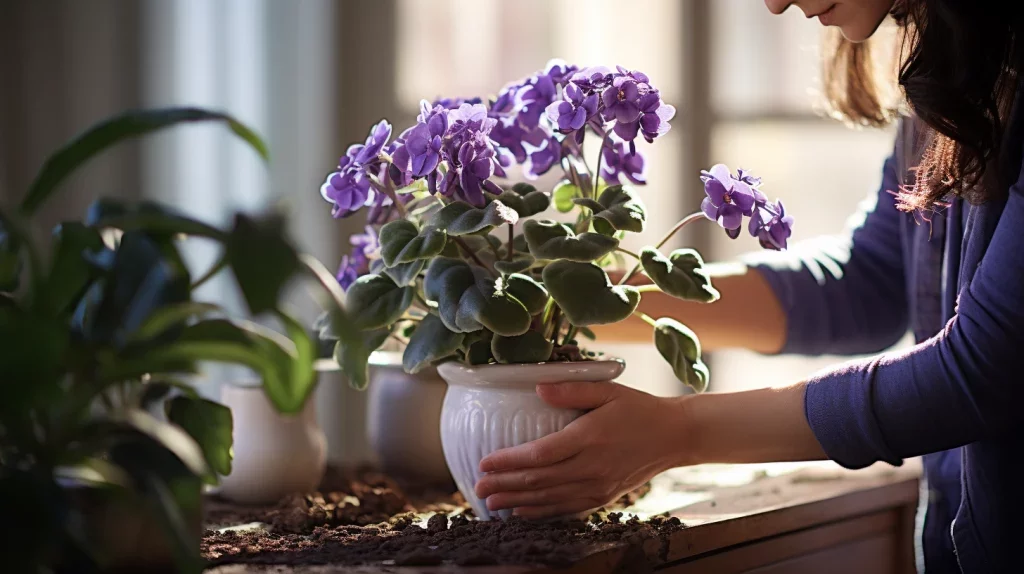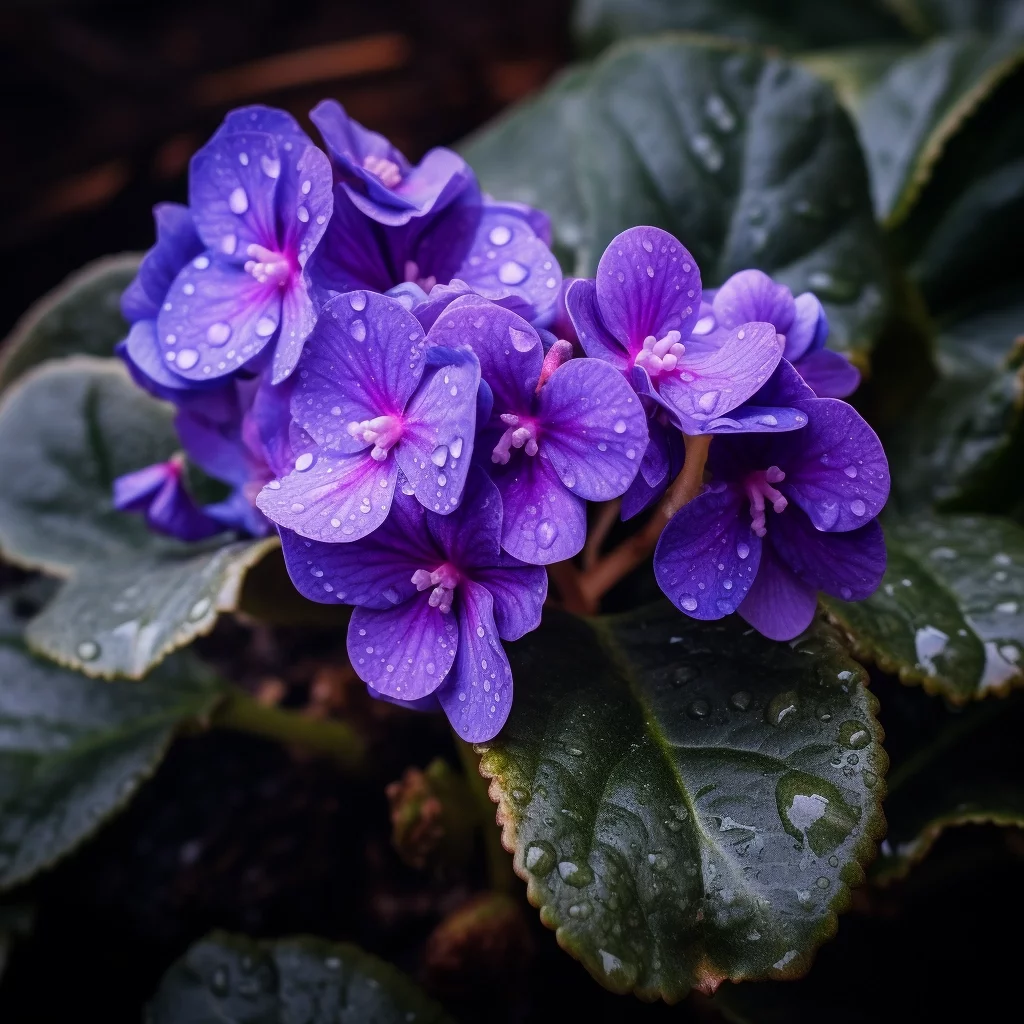Getting to Know Your African Violet
I’ve been growing African Violets, also known as Saintpaulia ionantha, for 5 years and they’re my absolute favorite houseplants. What makes them so special to me is their ability to bloom even in low light, and their stunning variety of bright flower colors. In this guide, I’ll share all my insights on how to care for these delightful plants. From my experience, I’ll help you ensure that your African Violets do more than just survive – they’ll thrive in your home!

History and Origin
African Violets, officially known as Saintpaulia ionantha, have a fascinating history that’s as colorful as their blooms. These captivating plants were first discovered in the cloud forests of Tanzania and Kenya by Baron Walter von Saint Paul-Illaire in 1892. Since their introduction to Europe and subsequently the rest of the world, they have become one of the most beloved houseplants. The name ‘African Violet’ is a bit of a misnomer, as they are not true violets but share some similarities in appearance.
The journey of African Violets from the East African forests to household favorites is a testament to their adaptability and charm. Their ability to thrive under typical indoor conditions has made them a staple in homes and offices, bringing a touch of nature’s beauty to indoor spaces.
Varieties and Characteristics
African Violets have evolved into numerous varieties, each with its unique charm. These varieties differ in leaf shape, color, and size, as well as flower form and color. Some popular varieties include the single-flowered type, the double-flowered type, and the ruffled varieties. Flower colors range from the deepest purples to vibrant blues, soft pinks, and pure whites. Some flowers even boast striking bi-colored patterns or delicate speckles.
The foliage of African Violets is also notable. Leaves can be variegated, ruffled, or heart-shaped, each adding to the plant’s ornamental value. These leaves form a rosette pattern, which further accentuates the beauty of the blooms that emerge from the center.
Additionally, African Violets are relatively small houseplants, making them perfect for spaces like windowsills, desks, and shelves. Despite their small size, they can make a big impact with their continuous flowering, sometimes blooming several times a year with proper care. This characteristic has made them a popular choice for plant enthusiasts who enjoy a long-lasting display of color indoors.
Symbolism and Cultural Impact
Beyond their physical allure, African Violets are steeped in rich symbolism. They’re often linked with motherhood, making them a cherished Mother’s Day gift. Furthermore, in the language of flowers, they represent faithfulness and loyalty, adding special meaning to gifts among friends and loved ones.
Culturally, African Violets have sparked a community of enthusiasts and collectors. These groups not only exchange care tips and propagation methods but also celebrate the plant’s diversity and beauty through shows and competitions. For instance, the African Violet Society of America plays a pivotal role in enhancing the growth and appreciation of these plants, solidifying their place as a beloved houseplant.
In conclusion, delving into the history, variety, and cultural importance of African Violets adds depth to the experience of nurturing them. Each variety offers a unique opportunity to explore and appreciate this species’ diversity. As living symbols of history, African Violets connect us to the broader narrative of plant cultivation and the collective joy of indoor gardening.
Ideal Growing Conditions
Light Requirements 🌞
African Violets prefer bright, indirect light. An east-facing window where they get morning sun is ideal. Too much direct sunlight can scorch their leaves, while too little can prevent them from flowering. If natural light is insufficient, consider using a grow light to supplement.
Temperature and Humidity
These plants thrive in temperatures between 65-75°F (18-24°C). They do not tolerate cold drafts or temperatures below 60°F (15°C). Humidity is also crucial, as African Violets prefer a more humid environment. Aim for 50-60% humidity. Using a humidifier or placing your plant on a tray with pebbles and water can help achieve this.
Feeding and Watering Your African Violet
Watering Techniques 💧
Watering is crucial in African Violet care. They prefer their soil to be consistently moist but not soggy. Use lukewarm water and water from the bottom to avoid getting water on the leaves, which can cause spots. Allow the pot to sit in water for about 30 minutes, then drain any excess.
Fertilizing Needs
Feed your African Violet with a balanced, water-soluble fertilizer every 4-6 weeks. Specialized African Violet fertilizers are available, which can provide the right nutrient balance. Be cautious not to over-fertilize, as this can lead to salt buildup in the soil.
Soil and Repotting
Choosing the Right Soil
The ideal soil for African Violets is light and well-draining. A mix specifically designed for African Violets, which often contains peat moss, perlite, and vermiculite, works best. Avoid heavy, garden soil as it can lead to root rot.
Repotting Steps
Repot your African Violet annually to refresh the soil. When repotting, choose a pot that is one-third the diameter of the plant’s leaf spread. Carefully remove the plant, trim off any dead or rotting roots, and replant in fresh soil.

Pruning and Propagation
Pruning for Health and Beauty ✂️
Regularly remove dead or wilted flowers and leaves to encourage new growth and flowering. This also helps prevent fungal diseases. Use a clean, sharp pair of scissors or pruning shears for this task.
Propagation Techniques
Propagating African Violets is relatively easy and can be done using leaf cuttings. Cut a healthy leaf with a stem, let it dry for a day, then plant it in a moist vermiculite or African Violet potting mix. Keep the soil moist and in a few weeks, new growth should appear.
Pest and Disease Management
Common Pests
African Violets may be prone to pests like aphids, mealybugs, and spider mites. Regularly inspect your plant and if pests are detected, use a gentle insecticidal soap or neem oil.
Disease Prevention
To prevent diseases, ensure good air circulation and avoid overwatering. Common diseases include root rot and powdery mildew. If symptoms appear, treat them promptly with appropriate fungicides and adjust your care routine.
Troubleshooting Common Problems
Leaf Issues
If your African Violet’s leaves are turning yellow, it might be due to overwatering or poor drainage. Brown leaf tips can indicate low humidity or over-fertilization.
Flowering Concerns
If your plant is not blooming, it may need more light. Ensure it’s receiving enough indirect sunlight or consider using a grow light. Also, check if it’s time to repot or if the plant needs fertilizing.
Fun Facts and Additional Tips
Historical and Cultural Significance
African Violets have a rich history and have been beloved for centuries. They symbolize faithfulness and were often given as gifts to express a commitment.
Joining Communities
Consider joining online forums or local clubs dedicated to African Violet enthusiasts. These communities can be a goldmine for tips, troubleshooting, and sharing your passion for these delightful plants.
Caring for African Violets is a rewarding endeavor. These charming plants bring color and life to any indoor space, and with the right care, they can bloom beautifully throughout the year. Whether you’re a seasoned gardener or a beginner, African Violets are a fantastic addition to your indoor plant collection. Embrace their beauty and enjoy the journey of nurturing these splendid botanical gems! 🌸💚

African Violet (Saintpaulia ionantha) FAQ: Everything You Need to Know 🌿
African Violets, or Saintpaulias, have graced our homes with their colorful blooms and fuzzy leaves for generations. Known as one of the world’s most popular houseplants, these small yet vibrant plants are beloved for their beauty and versatility.
1. How Do I Successfully Grow African Violets?
To grow Saintpaulias, provide them with bright, indirect light, maintain high humidity, and use an actual African violet potting mix. These plants do best in stable conditions without extreme temperature changes. Consistent care and attention to their unique needs are key.
2. What Is the Best Way to Water African Violet Plants?
Water African Violets from the bottom to prevent water on the foliage, which can cause leaf spots. Place the pot in a saucer filled with water and allow the plant to sit for about 30 minutes. This method helps avoid excess water and ensures the roots are adequately moist. Some gardeners use a wick system, where a wick runs from the bottom of the pot into a reservoir filled with water, providing consistent moisture.
3. How Often Should I Repot My Plant?
Repotting African Violets should occur every 6-12 months. Choose a pot only slightly larger than the current one, as African Violets do well when slightly root-bound. Gently remove the plant, trim any dead roots, and repot in fresh African violet potting mix.
4. What Are the Ideal Conditions for African Violets to Bloom?
To promote blooming in African Violets, start by providing them with enough indirect light, ideally from a south- or west-facing window. Next, ensure consistent moisture without waterlogging and fertilize them regularly during the growing seasons, which are spring and summer. Additionally, keeping the temperature around 70°F and maintaining high humidity is essential for their flowering.
5. Can I Use All-Purpose Potting Soil for My African Violets?
It’s recommended to use a potting mix specifically formulated for African Violets, consisting of equal parts of peat moss, perlite, and vermiculite. All-purpose potting soil may not provide the right drainage and aeration that these tropical plants require.
6. What Types of Pots Work Best for African Violets?
African Violets do well in small pots and can be planted in either plastic or clay pots. Self-watering pots are also a great option, as they help maintain consistent moisture levels. Ensure the pot has good drainage to prevent root rot.
7. Are There Different Types of African Violets?
Yes, there are hundreds of varieties and hybrids of African Violets, offering a range of leaf shapes, colors (from dark green leaves to variegated ones), and flower types (including purple flowers, star-shaped flowers, and clusters of white or pink blooms). Exploring these varieties can be a fascinating aspect of growing Saintpaulias.
8. How Do I Deal with Pests on My African Violets?
Common pests like cyclamen mites can affect African Violets. Inspect your plants regularly and if pests are found, isolate the affected plant from nearby plants and treat it with appropriate measures. For mild infestations, you can brush them off gently or use insecticidal soap.
9. Can African Violets Live for a Long Time?
With the right care, African Violets can enjoy a long lifespan, with some thriving for up to 50 years. To achieve this, regularly repotting them, ensuring proper watering, and avoiding stressors like extreme temperatures or over-fertilization are key steps to extend their lifespan.
10. How Can I Propagate African Violets?
Propagate African Violets by using a leaf stem cutting. Plant the stem in a moist potting mix, and in time, a new plantlet will form. This is a simple and effective way to create baby plants and expand your collection.
11. What Should I Do If the Leaves of My African Violet Are Turning Yellow?
Yellow leaves can be a sign of overwatering, poor drainage, or low light. Ensure the soil surface feels dry before watering again and provide your plant with bright, indirect light. Adjusting water needs and ensuring the plant is getting the right amount of light can often solve this issue.
12. Why Are My African Violet’s Flowers Not Opening?
If your African Violet is not blooming or the flowers aren’t opening, it may need more light. Move it to a location where it receives indirect but bright light, such as near a south- or west-facing window. Also, ensure it’s being cared for properly with the right humidity and temperature.
13. Can African Violets Be Grown in Offices or Low Light Areas?
Saintpaulia ionantha can adapt to lower light conditions, making them suitable for office environments or areas with less natural light. However, for optimal growth and flowering, consider using a grow light to provide additional light, especially if the natural light is insufficient.
14. How Do I Ensure High Humidity for My African Violets?
To maintain high humidity, which Saintpaulia ionantha loves, place the pot in a tray with pebbles and water, ensuring the bottom of the pot is not submerged. Alternatively, use a room humidifier or group plants together to create a microclimate with higher humidity.
15. Are African Violets Toxic to Pets?
African Violets are non-toxic to cats and dogs, making them a safe choice for pet owners. However, it’s always best to keep any houseplant out of reach of curious pets.
Introduction
Nicki Mann, based in Portland, Oregon, is a good writer and houseplant enthusiast. With her background in environmental science, Nicki specializes in indoor gardening, focusing on sustainable and organic practices.
Experience
Her interest in houseplants began in her mid-twenties, leading to a career writing articles about indoor plant care and eco-friendly gardening for various websites.
Education
Nicki holds a Bachelor of Science in Environmental Studies from the University of Oregon, which underpins her approach to indoor gardening. She continually enhances her knowledge through horticulture and environmental sustainability workshops.
Personal Life
Nicki, an avid nature lover, enjoys exploring the Pacific Northwest's trails. She's active in community gardening and lives with her two rescue cats, who share her interest in her growing collection of houseplants.


